Family : Scombridae

Text © Giuseppe Mazza

English translation by Mario Beltramini
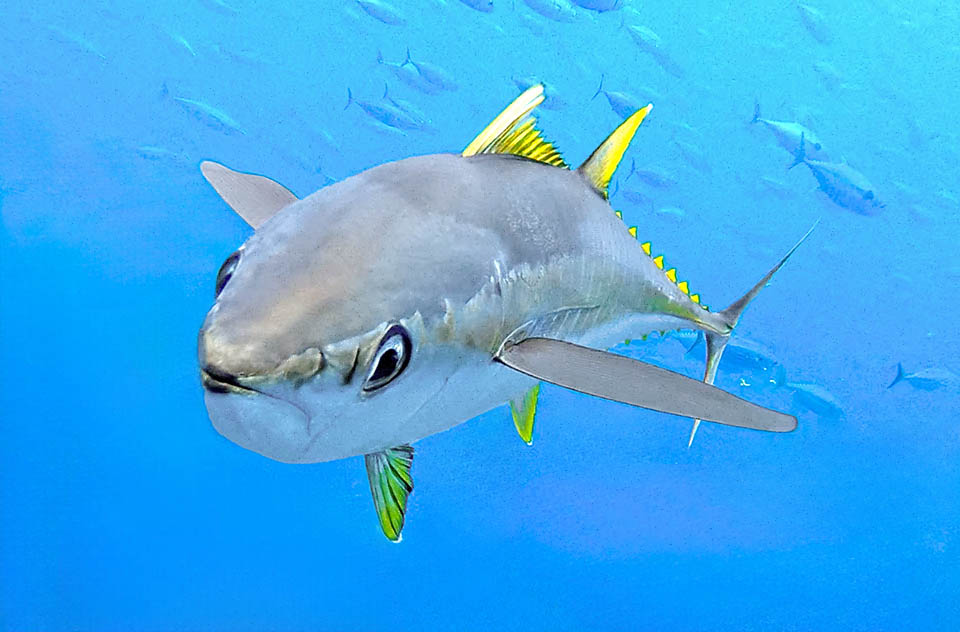
Highly migratory, Thunnus albacares, known as Yellowfin tuna or Albacore tuna, it frequents all warm waters of our planet © drsnapper
Who does not know the Yellowfin tuna, sometimes advertised in a relentless way as the best by the canned tuna manufacturers?
Actually, its flesh is less valuable than that of the Atlantic bluefin tuna (Thunnus thynnus), but the users don(t know this, whilst it costs manufacturers significantly less and is easier to work with.
Known also as Albacore tuna, it bears the scientific name of Thunnus albacares (Bonnaterre, 1788) inserted in the class of the Actinopterygii, the ray-finned fish, in the order of Perciformes and in the family of Scombridae, counting presently 15 genera and 54 species.
The original generic term was Thynnus, from the Greek “thynnos”, tuna, but in 1816 Cuvier changed it to Thunnus because Thynnus had been already used by Fabricius in 1775 for a hymenopteran.
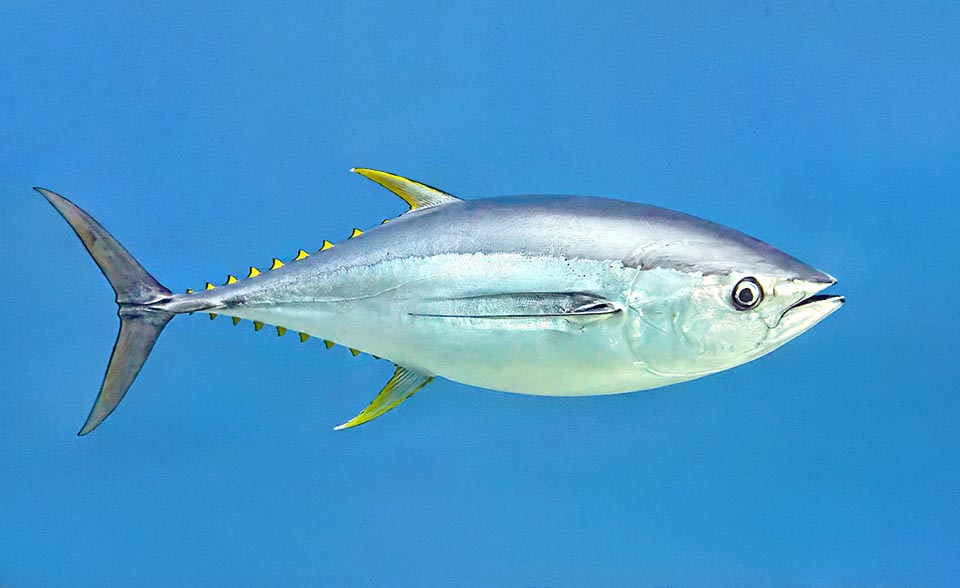
Smaller than Bluefin tuna (Thunnus thynnus), reaches 239 cm and 200 kg, but its current length is 150 cm © www.carlosestape.photoshelter
The specific term of albacares given by Bonnaterre, originates from the Arabic “al e bacora”, that means “little pig”, hence in Jamaica the Portuguese name of “Albicores”.
Zoogeography
Highly migratory species, Thunnus albacares is present in all warm waters of our planet having mainly temperatures between 15 and 31 °C, especially in the southern Atlantic, Caribbean, Indian Ocean and the western Pacific.
Ecology-Habitat
The Yellowfin tuna usually goes swimming between 1 and 250 m in depth, even if it can go down up to about 1600 m and effect dramatic leaps out of the water in pursuit of the prey.
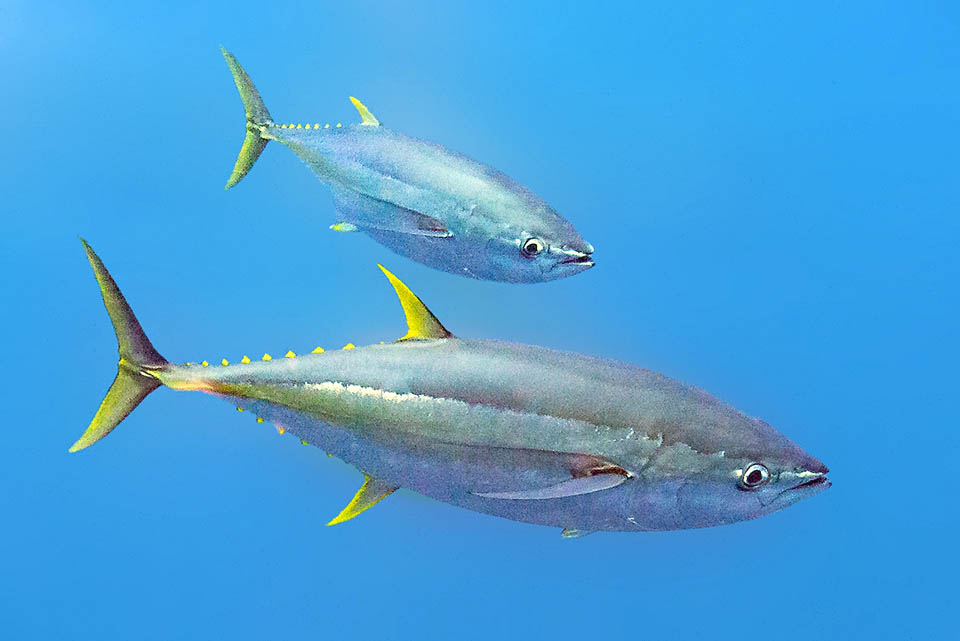
At first sight distinguishes from Bluefin tuna due to the dazzling yellow dorsal fins like pinnulae and anal. To note the showy caudal keel standing between the two smaller © www.carlosestape.photoshelter
Morphophysiology
Thunnus albacares reaches 239 cm and 200 kg, but its current length is 150 cm.
At first sight can be distinguished from the Atlantic bluefin tuna due to the dazzling yellow dorsal fins like the anal, located symmetrically to the second. Both latter have the lobe falcate and a showy extension in the old specimens.
Also the 8-9 upper pinnulae and the 7-10 lower ones are bright yellow, whilst on the caudal fin, very forked for a fast swimming, the golden shades attenuate in a yellowish grey like the pelvic ones.
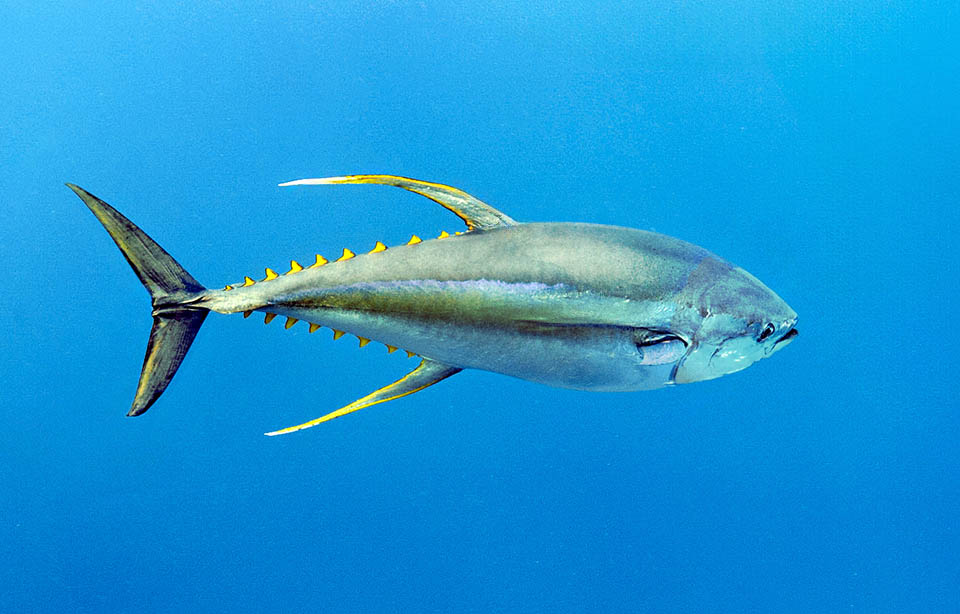
In the old specimens, the second dorsal fin and the anal are very elongated © Programa Marino del Golfo de California
The moderately long pectoral fins are even darker with round point in the less 110 cm specimens, where the dark metallic blue of the back tending to the silver yellow towards the belly, has about twenty whitish lines, almost vertical, that cross it alternate with bars continue or interrupted by a clear dotting.
The fusiform body, slightly compressed on the sides, is protected by very tiny scales and the outline of a corset with big lines. The lateral line is complete.
The caudal, thin, peduncle has on the sides, like in the Black skipjack Euthynnus lineatus, a keel located between the two smallest ones and has that particular muscle network that raises slightly the body temperature compared to the sea thus increasing the performance.
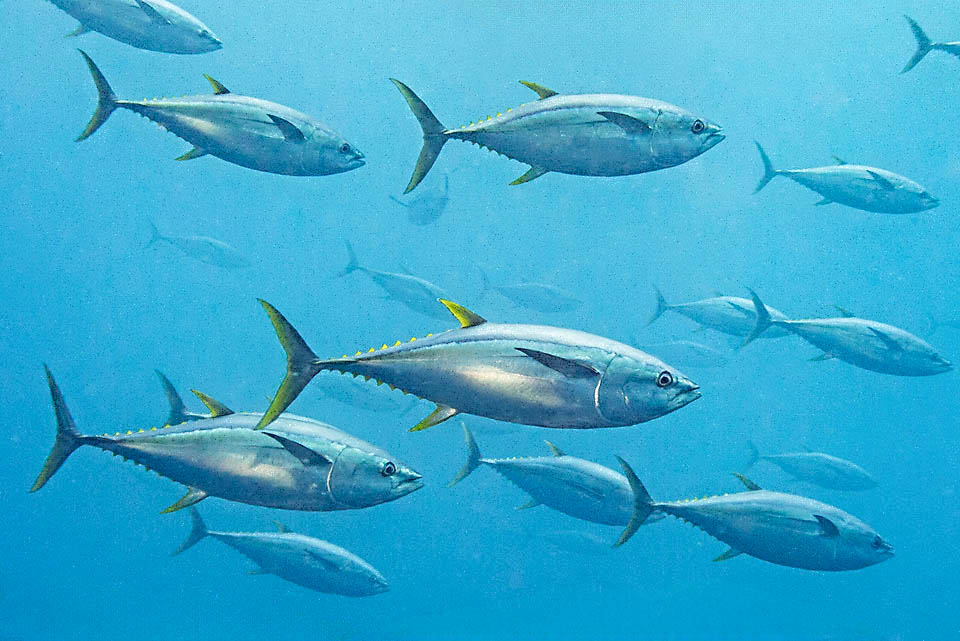
Thunnus albacares forms schools with individuals of the same size, often integrated by the dolphin Stenella attenuata, kept on eye by fishermen to hunt the tuna © www.carlosestape.photoshelter
But, unlike Euthynnus lineatus, which doesn’t have it, it has a swim bladder.
The mouth, placed in a terminal position, has tiny conical teeth and on the tongue we note two cartilaginous crests.
Ethology-Reproductive Biology
The diet of Thunnus albacares is similar to that of Thunnus thynnus. It feeds in an opportunistic manner on fish, squids, crustaceans and zooplankton, forming schools with individuals having the same size, to which often associate those of Stenella attenuata, a pantropical spotted dolphin the fishermen often utilize as reference for casting the tuna nets, regardless of the fact that hunting it often they kill also the cetacean.
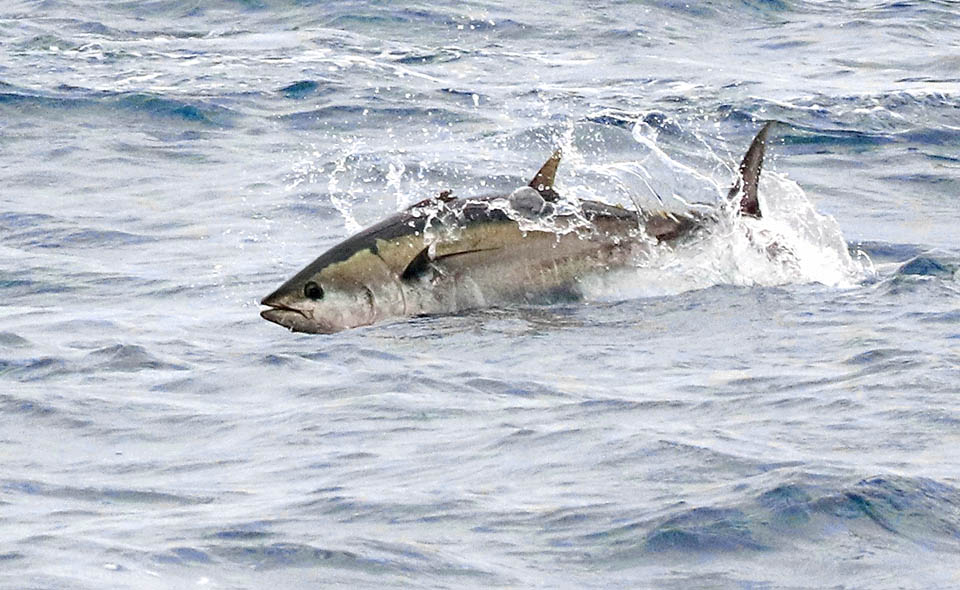
The Yellowfin tuna feeds in opportunistic way on zooplankton, crustaceans, squids and fishes it follows even in surface © James Bailey
The Yellowfin tuna may live 9 years and reach the sexual maturity when about one metre long.
The reproduction, which takes place almost exclusively by night with gametes entrusted to the currents, occurs all the year round in the tropics and during summer in the less warm waters.
Females lay thousands of eggs repeatedly, with an interval very short of a few days between one laying and another, and the larvae are pelagic.
The resilience is average, with a minimum time for doubling the populations of 1,4-4,4 years and the fishing vulnerability, of 46 on a scale of 100, is still acceptable, so much so that Thunnus albacares appears as “LC, Least Concern”, in the IUCN Red List of the endangered species.
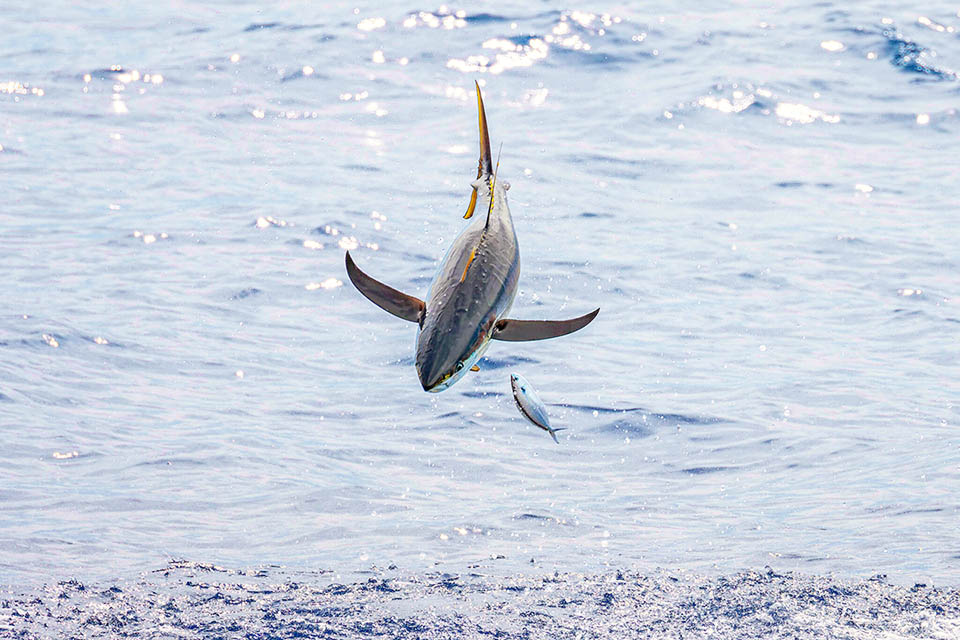
Just to catch it, this has almost reached the beach. Thunnus albacares is widely fished for the canned tuna industry, but nowadays is not considered as endangered © Oscar Thomas
Synonyms
Scomber albacares Bonnaterre, 1788; Germo albacares (Bonnaterre, 1788); Neothunnus albacares (Bonnaterre, 1788); Thynnus argentivittatus Cuvier, 1832; Germo argentivittatus (Cuvier, 1832); Neothunnus argentivittatus (Cuvier, 1832); Thunnus argentivittatus (Cuvier, 1832); Scomber sloanei Cuvier, 1832; Thynnus albacora Lowe, 1839; Germo albacora (Lowe, 1839); Neothunnus albacora (Lowe, 1839); Orcynus albacora (Lowe, 1839); Thunnus albacora (Lowe, 1839); Thynnus macropterus Temminck & Schlegel, 1844; Germo macropterus (Temminck & Schlegel, 1844); Neothunnus albacora macropterus (Temminck & Schlegel, 1844); Neothunnus macropterus (Temminck & Schlegel, 1844); Neothunnus macropterus macropterus (Temminck & Schlegel, 1844); Orcynus macropterus (Temminck & Schlegel, 1844); Thunnus albacares macropterus (Temminck & Schlegel, 1844); Thunnus macropterus (Temminck & Schlegel, 1844); Orcynus subulatus Poey, 1875; Thunnus allisoni Mowbray, 1920; Germo allisoni (Mowbray, 1920); Neothunnus allisoni (Mowbray, 1920); Neothunnus itosibi Jordan & Evermann, 1926; Germo itosibi (Jordan & Evermann, 1926); Neothunnus macropterus itosibi Jordan & Evermann, 1926; Semathunnus itosibi (Jordan & Evermann, 1926); Thunnus itosibi (Jordan & Evermann, 1926); Neothunnus catalinae Jordan & Evermann, 1926; Thunnus catalinae (Jordan & Evermann, 1926); Kishinoella zacalles Jordan & Evermann, 1926; Thunnus zacalles (Jordan & Evermann, 1926); Semathunnus guildi Fowler, 1933; Neothunnus albacora f. longipinna Bellón & Bardán de Bellón, 1949; Neothunnus albacora f. brevipinna Bellón & Bardán de Bellón, 1949; Neothunnus brevipinna Bellón & Bàrdan de Bellón, 1949.
→ For general information about FISH please click here.
→ For general information about BONY FISH please click here
→ For general information about CARTILAGINOUS FISH please click here.
→ To appreciate the BIODIVERSITY of BONY FISH please click here.
→ To appreciate the BIODIVERSITY of CARTILAGINOUS FISH please click here.
